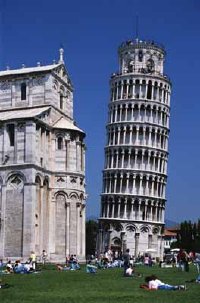One of the world's most recognizable buildings is surely the Leaning Tower of Pisa. Go see it, if you're so inclined....
Tourists stand in front of the tipsy tower, leaning at a jaunty angle themselves, and take snapshots in which they seem to disobey the laws of gravity. In fact, people have been having fun with the tower's tilt for centuries.
 ©Photodisc The white marble tower was designed as a complement to Pisa's cathedral. See more pictures of famous landmarks. |
When construction of this campanile began in 1173, Pisa was a trading center at the peak of its military might and artistic achievement. Much to the embarrassment of Pisans, however, their white marble tower began to tilt even before its third story was finished in 1274.
Perhaps engineer Bonanno Pisano failed to consider the consequences of designing a 185-foot-tall tower with a stone foundation only about ten feet thick. And this thin base rests on soft sand, rubble, and clay -- not firm underpinnings for an almost 16,000-ton tower. The structure continued to settle unevenly.
Nonetheless, construction continued. To make up for the tilt, builders made each new tier a little taller on the short side -- but the additional stone only made the tower sink more. Upon completion in 1350, the tower was leaning a full 4 feet, 7 inches from vertical.
Up in the belfry, the weight of the bells caused the structure to tilt even further. By the late 20th century the tower was leaning more than 17 feet toward the south, and a rescue operation was begun. Engineers removed soil from under the north side of the tower to even out the differences in the foundation. During the restoration, visitors were not allowed to enter the tower and climb the 293-step spiral staircase to the top. The lean was reduced by more than 15 inches. Hard to believe? What else would you expect for a tower standing on what Pisans call the Campo dei Miracoli -- the Field of Miracles.
Here are links to dozens of other world-famous landmarks:
| Abu Simbel, Egypt | History of Italy ABOUT THE AUTHOR: Jerry Camarillo Dunn, Jr., has worked with the National Geographic Society for more than 20 years, starting as a staff editor, writer, and columnist at Traveler magazine, then writing travel guides. His latest work is National Geographic Traveler: San Francisco. Dunn’s Smithsonian Guide to Historic America: The Rocky Mountain States has sold more than 100,000 copies. His travel pieces appear in newspapers such as the Chicago Tribune and The Boston Globe. Jerry Dunn's stories have won three Lowell Thomas Awards from the Society of American Travel Writers -- the highest honor in the field. He also wrote and hosted a pilot episode for a travel show produced by WGBH, Boston's public television station. Advertisement
Cite This!
Please copy/paste the following text to properly cite this HowStuffWorks.com article: Advertisement
Loading...
|